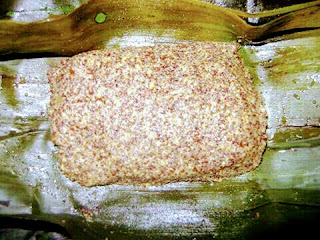
Black mustard seeds
Today's recipe is about a chutney made from black mustard seeds. Many of you may have tasted yellow mustard seeds' chutney but have you ever tasted black mustard seeds' chutney ? Well, Black mustard seeds taste little bitter than yellow mustard seeds. There are two different black mustard seeds' chutney. One is called panitenga and the other is called kharoli in Assamese. The taste of panitenga is not bitter but little tangy and very strong and the taste of kharoli is also not bitter but has a strong mustard flavour.
Black mustard seeds are used to produce mustard oil. Mustard oil is an integral part of Assamese cuisine. Assamese people use mustard oil in everyday cooking. They also use raw mustard oil in salads and pitikas. We can say mustard oil is an Assamese version of olive oil. But mustard oil has a strong smell and taste and therefore everyone may not like to consume it as raw.
Panitenga and kharoli are unique recipes of its kind. Because of its strong flavour it is good for sneezing or runny nose. Assamese people love to have panitenga or
kharoli as a side dish with rice.
The recipe of panitenga and kharoli are almost same. The difference is that in panitenga we use garcinia pulp which is very sour and for making kharoli we use khar.

Panitenga /kharoli
Panitenga Recipe :
📎Course : Side dish (chutney)
📎Cuisine : Assamese
INGREDIENTS:
- 100 gms black mustard seeds
- 1/2 cup thekera pulp (Garcinia pulp)
- Banana leaf
- Salt to taste
- Sugar 1 pince
METHOD:
- Wash black mustard seeds and dry completely.
- Grind mustard seeds.
- Mix all the ingredients and make a dough.
- Tendar the banana leaf by heating on fire.
- Now wrap the dough with banana leaf and tie it with a string. Keep it aside for 3-4 days for fermentation. I used to keep them in an airtight container for three days.
- After 3-4 days panitenga is ready to serve.
- It is tangy as well as very strong in taste.
- While serving it we can add chopped green chilies and 1/2 tbsp of mustard oil in it.

Panitenga kept for fermentation
Kharoli Recipe :
📎Course : Side dish (chutney)
📎Cuisine : Assamese
INGREDIENTS:
- 100 gms black mustard seeds
- 1/2 cup khar
- Banana leaf
- Salt to taste
- Sugar 1 pince
METHOD:
- Wash black mustard seeds and dry completely.
- Grind mustard seeds.
- Mix all the ingredients and make a dough.
- Tendar the banana leaf by heating on fire.
- Now wrap the dough with banana leaf and tie it with a string. Keep it aside for 3-4 days for fermentation. I used to keep them in an airtight container for three days.
- After 3-4 days kharoli is ready to serve.
- It is very strong in taste.
- While serving it we can add chopped green chilies and 1/2 tbsp of mustard oil in it.
New items always welcome.Nice post.
ReplyDeleteThank you very much pranita ☺
DeleteThough i dont like chutney much and rarely take it yet am habituated with different names but this one seems totally new to me, will love to try.
ReplyDeleteIt's taste is different from other chutneys.. Try it. . You'll definitely like it jyotirmoy ☺
DeleteUsefull details
ReplyDeleteThank you
Delete